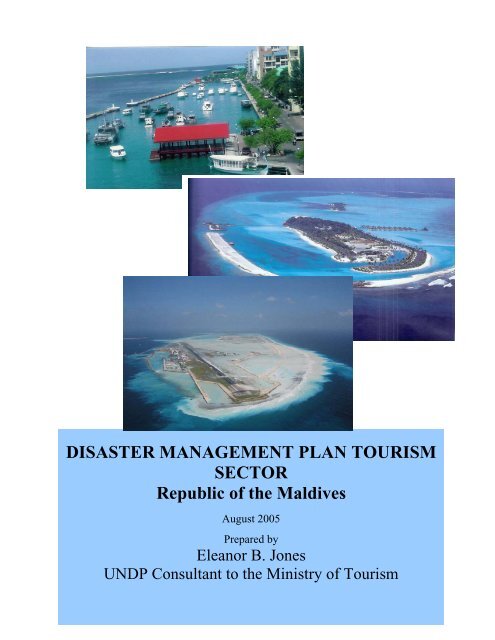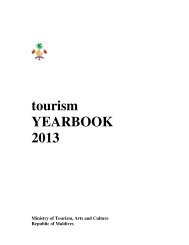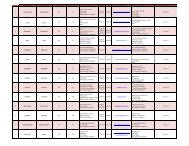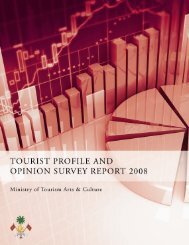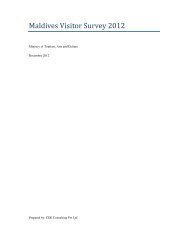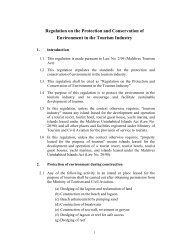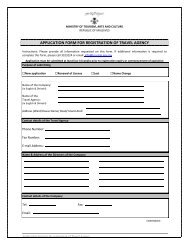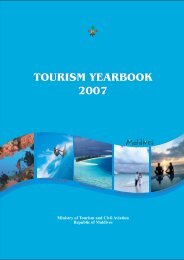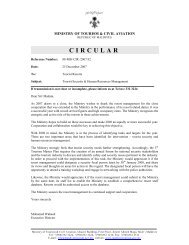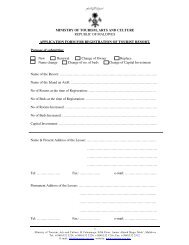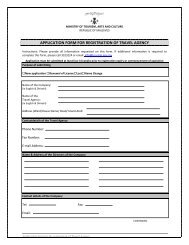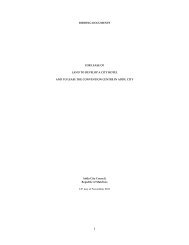English (PDF) - Ministry of Tourism Arts & Culture
English (PDF) - Ministry of Tourism Arts & Culture
English (PDF) - Ministry of Tourism Arts & Culture
You also want an ePaper? Increase the reach of your titles
YUMPU automatically turns print PDFs into web optimized ePapers that Google loves.
DISASTER MANAGEMENT PLAN TOURISMSECTORRepublic <strong>of</strong> the MaldivesAugust 2005Prepared byEleanor B. JonesUNDP Consultant to the <strong>Ministry</strong> <strong>of</strong> <strong>Tourism</strong>1
REPUBLIC OF THE MALDIVES – LOCATION2
FOREWORDThis disaster management plan/procedures manual was commissioned by the<strong>Ministry</strong> <strong>of</strong> <strong>Tourism</strong> <strong>of</strong> the Republic <strong>of</strong> the Maldives and supported by the UnitedNations Development Programme (UNDP) Recovery Support programme for theMaldives. The consultant, Eleanor B. Jones, an environmental management anddisaster risk reduction specialist, conducted several consultative meetings withseveral agencies <strong>of</strong> government and the tourism sector, visited resort and localislands, reviewed reports on the tsunami impact and recovery initiatives, documentson the natural hazards which have affected the Maldives, environmental attributesand threats in the Maldives as well as documents related to the physical, economicand social infrastructure <strong>of</strong> the Maldives, development planning , and characteristics<strong>of</strong> population and livelihood.The manual took full account <strong>of</strong> the geography <strong>of</strong> the Maldives, the institutional,administrative, legal and policy framework within which the tourism industry functions,and the significance <strong>of</strong> the industry to the economy <strong>of</strong> the Republic. Vulnerabilityarising from the distinctive geography and fragile physical form, low elevationjuxtaposed with sea level rise, increasingly erratic global weather patterns, monsoonweather, and long distance typhoon impacts, seismicity and the probability <strong>of</strong>earthquakes and tsunamis were all considerations in the development <strong>of</strong> theprocedures to be followed before, during and after a strike from a hazardous event.The manual attempts to suggest a results-based framework for disaster managementplanning, and Goals, Strategic Objectives, Results, and Tasks are presented for the<strong>Ministry</strong> <strong>of</strong> <strong>Tourism</strong> and for the Resort/Hotel sector.Completion <strong>of</strong> the manual within the short time frame would not have been possiblewithout the full cooperation and support <strong>of</strong> the <strong>Ministry</strong> <strong>of</strong> <strong>Tourism</strong> and in particular MrAhmed Salih and technical <strong>of</strong>ficers, Alshath Nahula and Shizna Waheed who wentthe “extra mile” to ensure that appointments were made and meetings facilitatedwithin Male and on the resorts and local islands. Resort Managers were especiallyhelpful as well, and the diversity and product <strong>of</strong> the resort islands were amplydemonstrated. The cooperation and graciousness <strong>of</strong> all persons contacted greatlyfacilitated the understanding <strong>of</strong> conditions in the Maldives and the context <strong>of</strong> thetourism sector.Special thanks to Mr. Man Thapa, Ms Rita Missal and Mr Rabi <strong>of</strong> the UNDP TsunamiRecovery Unit who facilitated the contractual arrangements and provided supportduring the research, development and presentation stages <strong>of</strong> the document.Participants at the two workshop presentations provided valuable feedback on thedraft document and further assisted clarification <strong>of</strong> issues related to disastermanagement in the Maldives.I humbly express my heartfelt gratitude to all who contributed so willingly andpr<strong>of</strong>essionally.Eleanor B. JonesUNDP Consultant to the <strong>Ministry</strong> <strong>of</strong> <strong>Tourism</strong>Republic <strong>of</strong> the MaldivesJuly – August 20053
REPUBLIC OF THE MALDIVESDISASTER MANAGEMENTSTRATEGIC FRAMEWORK ANDPROCEDURES MANUALTOURISM SECTOR5
SECTION A. SITUATIONAL CONTEXT1.0 This DocumentThis document outlines a Disaster Management Strategy and Plan for the <strong>Tourism</strong>Sector <strong>of</strong> the Republic <strong>of</strong> the Maldives. Commissioned by the <strong>Ministry</strong> <strong>of</strong> <strong>Tourism</strong>and supported by the UNDP Tsunami Recovery Programme, the plan seeks to meetthe requirements <strong>of</strong> the <strong>Ministry</strong> <strong>of</strong> <strong>Tourism</strong> and the Hotel/Resort Sector fordocumented procedures to reduce risk and to facilitate effective response andrecovery from any hazardous event, which may lead to a disaster or a crisis. TheUNDP’s Disaster Management Strategy for the Republic outlined assistance to the<strong>Ministry</strong> <strong>of</strong> <strong>Tourism</strong> and to the Republic for development <strong>of</strong> a sector plan and aNational Disaster Plan, respectively.The document has been organised into five Main sections. The first section presentsa situational context for development <strong>of</strong> the Disaster Management Plan for theRepublic <strong>of</strong> the Maldives. The Second Section, B, outlines a basic strategic resultsbasedframework for the industry. In Section C, disaster management procedures forthe Hotel/Resort sector are outlined, and Evacuation Procedures, CrisisCommunications Procedures and Insurance considerations are included as Annexesin Section D. The final and fifth Section E includes Sample forms for use by theResort in the Disaster Management programme. Procedures are presented forimplementation Before, During and After an Event.2.0 The Maldives <strong>Tourism</strong> SectorThe tourism sector is the mainstay <strong>of</strong> the Maldivian economy. Recent experiencewith the tsunami demonstrated the vulnerability <strong>of</strong> the Republic to the reaction <strong>of</strong> theinternational tourism market in the wake <strong>of</strong> extensive media reporting on a disaster,which had differential impact within southern and south-eastern Asia as well as withinthe Maldives. The industry is reported to contribute 30% directly and 70% indirectlyto GDP, and in addition contributes to government revenue through taxes, leasesand customs duties. Some 25,000 jobs are directly linked to the industry, which6
comprises 87 resorts on the resort islands, 100 safari vessels and 24 guest houses.Some 19,000 beds are available through the combined accommodations.The industry is private sector driven within government policy and targets the highendcomponent <strong>of</strong> the international travel market. The tsunami caused damage to 21resorts. Business loss has been estimated as well in excess <strong>of</strong> US$250million. Inexcess <strong>of</strong> US$100million is estimated for rebuilding and the government hasexpended considerable sums to regain the lost market through a significantmarketing thrust. Visitor arrival has been decimated with figures in January 2005reflecting 5,600 arrivals compared with 20, 000 in January 2004.7
The Republic had almost achieved the targets set out in the 10 year Master Planwhen the tsunami struck to set back the industry and the country substantially.Damaged resorts have been repaired and have reopened. Others are still underrestoration. Some resorts are reporting good occupancy levels and others arereceiving bookings for the winter season.Reinvestment has been proceeding apace and new resort licenses have beengranted. However, future development and management <strong>of</strong> the sector must takeaccount <strong>of</strong> the multi- hazard vulnerability <strong>of</strong> the industry.3.0 Multi-hazard Experience <strong>of</strong> the MaldivesFigure 1: Location <strong>of</strong><strong>Tourism</strong> ZoneDisaster risk reduction within the Maldives must beclosely aligned with the multi-hazard risk imbued bythe geography <strong>of</strong> the archipelagic marine state, andthe development patterns. Size, elevation, populationdistribution, and ocean corridors combine to generatea distinctiveness <strong>of</strong> character in this unique portion <strong>of</strong>southern Asia. Wide expanses <strong>of</strong> ocean betweenislands, boat transport as the medium for inter-islandmovement, fire, air and marine accidents, and oilspills are some <strong>of</strong> the technological hazards to beconsidered in addition to natural events.The nation <strong>of</strong> islands comprises a chain <strong>of</strong> some 1190islands as “drops in the Indian Ocean” in the form <strong>of</strong> a“necklace” <strong>of</strong> some 26 atolls, 20 <strong>of</strong> which have beenorganised into administrative units. The distancefrom north to south is approximately 900 kilometres,atolls stretching from just south <strong>of</strong> the equator to 4ºNorth latitude. The tourism sector occupies islandswithin some ten atolls mainly in the central portion <strong>of</strong>the Republic. (Figure 1)The location <strong>of</strong> the Maldives imbues the Republic withgeophysical and hydrometeorological consequences.8
Seismicity <strong>of</strong> the surrounding plate margins while not in the immediate vicinity <strong>of</strong> theMaldives causes earth tremours, and more recently the tsunami, which originatedsome 700 kms away was experienced. Monsoon weather patterns characterise theislands, but the impact <strong>of</strong> typhoons has occurred mainly in the form <strong>of</strong> storm waveswhich travel out as swell. Several destructive storms have been recorded in thenatural hazard history <strong>of</strong> the Maldives and therefore disaster planning must takethese into account.Prior to the tsunami the focus <strong>of</strong> disaster management was on the impact <strong>of</strong> globalwarming and sea level rise. The islands’ average elevation <strong>of</strong> 1.5 metres above sealevel makes them extremely vulnerable to the impact <strong>of</strong> rising sea levels, tsunami andstorm waves. Beach erosion is a perennial problem and is reported to occur onsome 88 <strong>of</strong> the 198 inhabited islands. Coral reefs play a major role in protecting theislands from storm waves and the environmental assessment <strong>of</strong> the tsunami impactseems to indicate that greater damage was experienced where there was coral reefdeterioration and loss <strong>of</strong> coastal vegetation.Environmental protection is therefore a key ingredient in risk reduction initiativeswithin the Maldives.4.0 DefinitionsDefinitions particularly applicable to disaster planning for the Maldives <strong>Tourism</strong> sectorinvolve the following:CrisisThe World <strong>Tourism</strong> Organisation (WTO) defines crisis as “any unexpected event thataffects traveller confidence in a destination and interferes with the ability to continueoperating normally”. The tsunami experience clearly falls into that category.HazardThe UN International Strategy for Disaster Reduction (ISDR) definition <strong>of</strong> a hazard is“a potentially damaging physical event, phenomenon or human activity that maycause the loss <strong>of</strong> life or injury, property damage, social and economic disruption orenvironmental degradation.” Hazards may therefore be natural events or they maybe human induced. Natural hazards are <strong>of</strong>ten part <strong>of</strong> natural systems, which shapethe earth (e.g. earthquakes, volcanic eruptions, tsunamis) or transfer heat energybetween latitudes (e.g. typhoons, monsoon rains). They are considered hazards9
ecause they have the latent potential to affect human activity. The Maldives lie in amulti-hazard environment as indicated in section 3 above.DisasterA disaster is considered to be “a serious disruption <strong>of</strong> the functioning <strong>of</strong> a communityor a society causing widespread human, material, economic or environmental losseswhich exceed the ability <strong>of</strong> the affected community or society to cope using its ownresources”. A disaster <strong>of</strong>ten results from the combination <strong>of</strong> hazard, vulnerability andinsufficient capacity or measures to reduce the potential negative consequences <strong>of</strong>risk. (ISDR, 2004)Disaster Risk ReductionThe ISDR and the Bureau <strong>of</strong> Crisis Prevention and Risk Reduction (BCPR) <strong>of</strong> theUnited Nations Development Programme (UNDP) now emphasise Disaster RiskReduction (DRR) as the focus for all countries. The goal <strong>of</strong> DRR is to reducedisaster losses, enhance development, and build resilience (coping capacity) tohazards. DRR requires a holistic approach and is applicable before, during and afterdisaster events. The recovery period is used as an opportunity to reduce disaster riskand to prevent the reconstruction <strong>of</strong> risk. To that end vulnerability reduction is acritical component <strong>of</strong> DRR and involves addressing the root causes <strong>of</strong> vulnerability.Effective disaster management planning in the Republic <strong>of</strong> the Maldives shouldtherefore consider the risk reduction approach, which involves building the capacityto reduce vulnerability and loss while enhancing sustainable development.Disaster Risk ManagementDisaster Risk Management involves a “ systematic process <strong>of</strong> using administrativedecisions, organization, operational skills and capacities to implement policies,strategies and coping capacities <strong>of</strong> the society and communities to lessen theimpacts <strong>of</strong> natural hazards and related environmental and technological disasters.This comprises all forms <strong>of</strong> activities, including structural and non-structuralmeasures to avoid (prevention) or to limit (mitigation and preparedness) adverseeffects <strong>of</strong> hazards.” (ISDR, 2004)10
RiskRisk involves the interaction between hazards and vulnerable conditions, and is <strong>of</strong>tenviewed in terms <strong>of</strong> probability <strong>of</strong> losses, especially monetary values. The ISDRdefines risk as “the probability <strong>of</strong> harmful consequences, or expected losses (deaths,injuries, property, livelihoods, economic activity disrupted or environment damaged)resulting from interactions between natural or human-induced hazards andvulnerable conditions”.Early Warning SystemsEarly Warning refers to the provision <strong>of</strong> timely and effective information, throughidentified institutions, that allows individuals exposed to a hazard to take action toavoid or reduce their risk and prepare for effective response. Early warning systemsinclude not only forecasting, but also very importantly dissemination <strong>of</strong> warnings,preparedness measures, and reaction capacities.Preparedness and Response“Activities and measures taken in advance to ensure effective response to the impact<strong>of</strong> hazards, including the issuance <strong>of</strong> timely and effective early warnings and thetemporary evacuation <strong>of</strong> people and property from threatened locations” isconsidered Preparedness. (ISDR, 2004).11
SECTION B. THE TOURISM SECTOR STRATEGY12
SECTION B. THE TOURISM SECTOR STRATEGY1.0 The Strategic FrameworkDisaster Management Planning for the <strong>Tourism</strong> sector in the Maldives must takeaccount <strong>of</strong> the distinctive nature <strong>of</strong> the Republic in terms <strong>of</strong> the low-lying, multi-islandcomposition <strong>of</strong> the State, growing population and increasing density on some islands,the heavy dependence on sea transport, the marine basis <strong>of</strong> its tourism product, andthe vulnerability <strong>of</strong> the archipelago to hazards <strong>of</strong> storm waves, sea level rise,earthquakes, and tsunamis as well as the man-made hazards <strong>of</strong> fire, and accidentsrelated to air and boat transport and recreation.Given the dependence <strong>of</strong> the Maldives on the tourism industry, sustainability is <strong>of</strong>paramount importance. Sustainable tourism development requires risk reductionconsiderations as well as sound management <strong>of</strong> the islands’ natural and builtenvironment, which is as distinctive as it is fragile. Vulnerability and RiskAssessment, and an effective Early Warning System are both germane to riskreduction, and both <strong>of</strong> these activities are currently being undertaken for the Maldivesunder the auspices <strong>of</strong> the UNDP.Given the understanding <strong>of</strong> the need for collaboration among the many stakeholders– government, resort, private entities, communities/citizens/civil society - and themultifaceted requirements <strong>of</strong> the industry, an outline Strategic Results –basedframework is suggested for consideration and adoption by the <strong>Ministry</strong> <strong>of</strong> <strong>Tourism</strong>and the Government <strong>of</strong> the Maldives. In addition it is recommended that as integral tothe Communications Strategy the <strong>Ministry</strong> establish an Emergency CoordinatingCommittee (ECC) and <strong>Tourism</strong> Emergency Operations Centre (TEOC), which willserve as the government’s focal point for the industry in the event <strong>of</strong> a crisis. Anadvisory panel comprising policy-makers from allied agencies should also beappointed for the ECC. This committee should not duplicate the National DisasterManagement Organisation (NDMO), but rather be tourism sector specific and serveas a complement to the NDMO.13
2.0 The Results Based FrameworkGOAL:STRATEGIC OBJECTIVE (SO):Sustainable <strong>Tourism</strong> in the MaldivesDisaster Resilient <strong>Tourism</strong> Sector6 Intermediate Results (IRs)IR1IR2IR3IR4IR5IR6Crisis Communication Procedures well-established, disseminated andfunctionalEnvironment and Safety Procedures developed and implementedVulnerability Assessment and DRR Due diligence Procedures establishedand Recommendations implementedFiscal and interagency measures established and operationalCapacity Building Programmes developed and being implementedDRR Recovery guidelines developed and integrated into developmentplanning for the Industry(Figure B1)14
FIGURE B 1: RESULTS-BASED STRATEGIC DISASTER MANAGEMENT FRAMEWORK – TOURISM SECTORGoalSustainable <strong>Tourism</strong> inMaldivesStrategic ObjectiveDisaster Resilient<strong>Tourism</strong> SectorIRICrisisCommunicationprocedures wellestablished,disseminatedand functionalIR2Environmentand SafetyProceduresdeveloped andimplementedIR3VulnerabilityAssessment andDRR DuediligenceProceduresestablished andRecommendationsimplementedIR4Fiscal andinteragencymeasuresestablished andoperationalIR5CapacityBuildingProgrammesdeveloped andbeingimplementedIR6Recoveryguidelinesdeveloped andintegrated intodevelopmentPlanning forthe Industry15
The detailed activities required to achieve the Intermediate Results are outlined below. Theachievement <strong>of</strong> each IR can in turn be measured by indicators.IR1. Crisis Communication Procedures well-established, disseminated and functional1. Establish <strong>Tourism</strong> Emergency Coordinating Committee – Min. <strong>Tourism</strong>, MATI, MTPB et al(Figure B2)2. Establish Advisory Body comprising policy makers critical to the management <strong>of</strong> crises inthe tourism sector3. Establish Location for <strong>Tourism</strong> Emergency Operations Centre (TEOC)4. Obtain telecommunications network – satellite phones, VHF radios, (or similarcommunication with resorts) internet facilities5. Establish communication focal points and protocols with Meteorological Dept – EarlyWarning System, National Disaster Management Centre, Airport, Port (?), Fire Department,hospitals, transport sector, other relevant agencies <strong>of</strong> government6. Link Alert phase with EWS colour coding system <strong>of</strong> current National EmergencyProcedures7. Establish communication focal points and protocols with resorts8. Connect airports, which already exist – e.g Gan for management <strong>of</strong> distant resorts.9. Mandate establishment and use <strong>of</strong> emergency telecom system in key agencies (e.g.satellite phones) for emergency communication10. Establish communication focal points in the marketplace – Germany Office, embassies,and PR companies. Establish protocol for information dissemination – phases andschedule.11. Link communication with safari and other vessels and establish protocol for situationreports12. Develop Mutual Aid Agreements (MOU) among resorts, seaplanes, fixed wing aircraft,boating sector, and non-resort islands13. Develop Media policy in keeping with policy for resorts.14. Establish central database on visitors – feed in from immigration, resorts, safari boats, andsecurity15. Join WTO Safety and Security NetworkIR2Environment and Safety Procedures developed and implemented1. Integrate Disaster plan for Airport and Coast guard (NSS) into operations <strong>of</strong> <strong>Tourism</strong>Emergency Operations Centre16
2. Mandate schedule for simulation exercises at critical facilities – twice per year atminimum – 1 desk and one field (especially fire, earthquake and tsunami drill, aircraftcrash and airport evacuation procedures)3. Enforce safety regulations for resort boating sector4. Regulate anchoring protocol for safari boats5. Integrate Disaster plan for Airport and Coast guard (NSS) into operations <strong>of</strong> <strong>Tourism</strong>Emergency Operations Centre6. Mandate schedule for simulation exercises at critical facilities – twice per year atminimum – 1 desk and one field (especially fire, earthquake and tsunami drill, aircraftcrash and airport evacuation procedures)7. Enforce safety regulations for resort boating sector8. Regulate anchoring protocol for safari boats9. Establish policy in industry re management <strong>of</strong> staff safetyIR3Vulnerability Assessment and DRR Due diligence Procedures establishedand Recommendations implemented1. Utilize UNDP Vulnerability and Risk Pr<strong>of</strong>ile <strong>of</strong> the Maldives (under development) toinform tourism related safety procedures and capability requirements• Airport• Port• Docks• Hospitals• Health Centres• Fire Service• Security services• Fuel storage• Water supply facilities17
2. Implement risk reduction measures for• Runway• Navigation equipment• Power generating facilities• Telecommunication systems• Fuel storage3. Use Risk Pr<strong>of</strong>ile being developed by UNDP to establish and Regulate safe zoneson each resort island as is feasible, and safe islands within the archipelago.4. Regulate Mutual aid agreement for evacuation and protocol where safe zone onisland is not possible5. Establish construction/building codes to support DRR – building height, coastalprotection – structural and non-structural6. Enforce environmental protection in collaboration with <strong>Ministry</strong> <strong>of</strong> Environment asoutlined in IR 2.7. Establish and enforce safety standards for restaurants – food safety, fireprevention, safety exitsIR4Fiscal and interagency measures established and operational1. Establish Contingency fund in GOM budget for emergency expenditures2. Provide fiscal incentives to support rehabilitation3. Explore establishment <strong>of</strong> private-public partnership for insurance coverage4. Establish Mutual Aid agreements (MOU) with Airlines for out <strong>of</strong> country evacuation5. Establish <strong>of</strong>f-island evacuation protocol with transport companies6. Establish evacuation zoning based on vulnerability assessment <strong>of</strong> islands7. Establish linkages with host communities on neighbouring islands8. Establish linkages for management <strong>of</strong> distant islands – especially new resorts.18
9. Establish data base <strong>of</strong> tourism employment – source islands, and respectivevulnerabilities - develop interagency agreements for transport and safety10. Link tourism plan with other sector plans viz. Health, Hospital and Medical centres.IR5Capacity Building Programmes developed and being implemented1. In collaboration with NDMO utilise training needs assessment to develop trainingprogrammes for disaster risk reduction in the industry2. Develop disaster management functions for <strong>Ministry</strong> <strong>of</strong> <strong>Tourism</strong> Management and staffand insert in job descriptions and accountabilities3. Nominate persons from the <strong>Ministry</strong> to participate in training program <strong>of</strong> National DisasterManagement Organisation.4. Develop and/or strengthen food safety training and certification5. Strengthen Search and Rescue capability – land and sea – in collaboration with NDMCand NSS/Coast Guard/fire service6. Strengthen First Responder /First Aid Training for Boat Operators and within resorts andneighbouring communities7. Seek training to strengthen Evacuation Procedures8. Strengthen Data Management Capability within the <strong>Ministry</strong> and affiliate agencies9. Build Fire Prevention and Fire Suppression capacity within the fire service and at resortlevel.10. Strengthen safety and security training for resorts11. Establish technical training in the relevant communication systems12. Seek training for strengthening NSS in procedures for minimizing terrorist exposure.19
IR6. DRR Recovery guidelines developed and integrated into development planning forthe Industry1. Utilise findings <strong>of</strong> Damage Assessments and Impact evaluations to inform rehabilitationguidelines and recovery planning2. Seek technical assistance to develop recovery guidelines for the industry in the light <strong>of</strong>sustainable tourism development3. Establish working relationship with 7 th National Development Planning Programme toensure integration <strong>of</strong> standards for sustainability.4. Develop Building codes/standards for the resort sector5. Include environmentally appropriate Waste Management procedures in recovery protocol6. Review, revise (as necessary) and enforce Environmental StandardsThe Emergency Coordinating CommitteeThe <strong>Ministry</strong> <strong>of</strong> <strong>Tourism</strong> Emergency Coordinating Committee should be named and should haveas its Core, representatives <strong>of</strong> the <strong>Ministry</strong>, the Maldives <strong>Tourism</strong> Promotion Board (MTPB) andthe Maldives Association <strong>of</strong> <strong>Tourism</strong> Industries (MATI), and should include representatives fromkey link agencies (Figure B2). The <strong>Ministry</strong> will appoint a Leader and a Spokesperson, willDevelop and Maintain contact List <strong>of</strong> key persons and agencies (address, telephone) and willoperationalise the communications protocol - IR 1. The Emergency Coordinating Committeeshould have an advisory body comprising policy makers from agencies critical to tourism sectorresponse and recovery.A location for a <strong>Tourism</strong> Emergency Operations Centre (TEOC) should be identified and thiscentre should be equipped with Radio communication, satellite phones, Internet access (bank <strong>of</strong>computers), situation reporting facilities (Boards, maps, etc.) and comfort facilities for staff. The<strong>Ministry</strong> has indicated that the Conference room that operated during the tsunami would be theprobable location, radio and other necessary facilities will need to be put in place.The overall function <strong>of</strong> the Emergency Coordinating Committee and the TEOC will be Command,Coordination, Communication and Control.20
ATOLLDEVELOPMENTNDMCADVISORYBODY OFPOLICYMAKERSMIN.FOREIGNAFFAIRSTRANSPORTSEAPLANESFIXED WINGBOATINGREPS.HEALTHTEOCMINISTRY OFTOURISMMATIMTPBMET.SERVICEEWSAIRPORTSPORTS &HARBOURSIMMIGRATIONCUSTOMSDEFENSECOAST GUARDPOLICENSSSEARCH &RESCUEMEDIARESORTEMERGENCYOPERATIONSCENTERSTOUROPERATORSFigure B2– <strong>Tourism</strong> Emergency Operations Centre21
SECTION C. HOTEL/RESORT SECTORDISASTER MANAGEMENT PROCEDURES MANUAL22
PART I.THE PROCEDURES MANUAL AND ITS CONTEXT1.0 The Procedures Manual – Format and Approach1.1 This disaster management procedures manual has been prepared to meet the recognizedneeds for preparedness and response planning in the resort sector <strong>of</strong> the Republic <strong>of</strong> theMaldives. Preparedness planning can help to reduce loss and dislocation, facilitate safety andcomfort <strong>of</strong> guests and staff, and assist speedy resumption <strong>of</strong> business after the event.1.2 There are some initiatives, which need to be taken by the individual resort owner/operator;others require partnerships among hoteliers or between hoteliers and selected stakeholderswithin the sector and the community; and still others require national and even regionalcollaboration.1.3 The time to prepare or plan is Before an Event. The plan therefore, outlines the steps andactivities, which need to be taken before an event. Managing the property, guests, and staffDuring an event is crucial to guest safety and comfort and to business continuity thereafter.Immediately following a strike, there are several critical issues to be dealt with, and in the Sectionentitled After the Event guidelines for business recovery are outlined.1.4 The plan has been designed to provide recommendations, tasks, and responsibilities foreach major department within the facility. It allows for distribution <strong>of</strong> sections <strong>of</strong> the plan to therelevant departments, while at the same time allowing for the holistic application <strong>of</strong> the entireplan. Procedures and responsibility by department or function are outlined for preparedness andresponse, recovery, vulnerability assessment, guest relations, and crisis communications.2.0 Testing, Maintaining, and Upgrading Procedures2.1 This manual is a written document. It becomes a “plan” when the procedures outlined aretested, and the details for each property and department worked out and corrected throughtraining drills and simulation exercises.2.2 Additionally, the procedures must be integrated into the overall management plan for theorganization in terms <strong>of</strong> company policy, operational budget, training, and job descriptions.Training is vital to the success <strong>of</strong> disaster management, and properties should seek to23
communicate requirements to the respective staff, and to implement training programmes for therelevant procedures.Testing <strong>of</strong> the Plan Should:Confirm that ALL personnel understand their responsibilities and can successfully carrythem through.Serve as training for personnel.Be conducted at minimum on a bi- annual basis: one desk top and one fieldInclude consideration and review <strong>of</strong> the plan, incorporating changes, as these are foundnecessary.Evaluate vulnerability assessments and requirements for action.PART II. PROCEDURES FOR DISASTER MANAGEMENT1.0 Planning for the Phases <strong>of</strong> the Disaster Management CycleProcedures for effective disaster management and risk reduction should include planning for allphases <strong>of</strong> the disaster management cycle. Specific procedures apply• Before (Prevention and Preparedness/\Readiness),• During (Response) and• After (Restoration, Rehabilitation and Recovery) the event.The ultimate objective should be minimisation <strong>of</strong> loss <strong>of</strong> life and property and speedy resumption<strong>of</strong> business.2.0 Before the Event2.1 This phase should be ongoing throughout the year. All Departments have tasks, butleadership is given by the General Manager, and the Emergency Management Team.2.2 During this “Before” stage, attention should be given to:1. Creation <strong>of</strong> the Emergency Management Team/Coordinating Committee and assignment<strong>of</strong> responsibilities24
2. Vulnerability Assessment <strong>of</strong> physical plant and grounds, telecommunications systems –radios, phones, internet, - Power supply, Water supply3. Links with <strong>Ministry</strong> <strong>of</strong> <strong>Tourism</strong> Emergency Coordinating Committee re Early WarningSystems (EWS), Crisis Communications, Response and Recovery Planning4. Measures for Guest and Staff Security and Protection (Safe Zones/Evacuationprocedures, hospitality services, etc.)5. Preparation <strong>of</strong> Guest Information Packets6. Establishment <strong>of</strong> Mutual Aid Agreements (Memoranda <strong>of</strong> Understanding)7. Insurance coverage determination8. Vital records protection9. Safety and Emergency supplies10. Training programme for staff11. Development and Testing <strong>of</strong> the Contingency Plan12. Development <strong>of</strong> Crisis Communications ProceduresI. THE EMERGENCY MANAGEMENT TEAM (EMT)2.3 In order to ensure that this emergency procedures manual is an integral part <strong>of</strong> the cultureand practice in your resort, an emergency management team (EMT) should be established. Thisteam will serve as the overall coordinating and executing body for all emergencies and will beresponsible for managing and implementing procedures during all stages <strong>of</strong> a crisis event.Structure <strong>of</strong> the EMT2.4 The members <strong>of</strong> the EMERGENCY MANAGEMENT TEAM should be appointed bymanagement. At the head <strong>of</strong> the Team is the Emergency Coordinator. An Alternate EmergencyCoordinator should be designated in the event that the Emergency Coordinator is absent. Theteam should also consist <strong>of</strong> a public relations person, the environmental person (if your facilityhas one) and at least one representative from each <strong>of</strong> the departments or areas <strong>of</strong> the hotel orresort.25
These department representatives need not be department heads but can be any member <strong>of</strong> staffwho knows the department integrally and is capable <strong>of</strong> carrying out the requirements <strong>of</strong> acommittee member. Figure C1 outlines a possible structure <strong>of</strong> the Emergency ManagementTeam.The core coordinating function should reside with the General Manager, and Heads <strong>of</strong>Housekeeping, Food and Beverage and Engineering. However, all functions stipulated on thediagram should be included in planning and implementation <strong>of</strong> disaster management plan.Team ResponsibilitiesThe first four projects <strong>of</strong> the EM Team should be to:1. Familiarize themselves with the procedures2. Help the rest <strong>of</strong> the staff to become familiar with the procedures3. Designate responsibilities for action before, during and after an event.4. Meet quarterly to review departmental reports, review priority areas for action and reviewselected procedures.All departments at your resort or hotel should be included when responsibilities are beingassigned. These responsibilities should be made clear to each department and displayed in anopenly accessible place within the department.26
The Emergency Management Team StructureFood andBeverageCommuni-cationsSpecialist/PublicEnvironmentalOfficerKitchenEngineering/MaintenanceHouse-KeepingAnd LaundryGMF & BEngrHkeepingGeneralManagerSecurityLaundryGroundsFrontOffice/AdministrationTransportCoordinatorDivingInstructor/RecreationalcoordinatFigure C1: Emergency Management Team27
General Assignments for EMTeam Members:Team MemberCore CoordinationTeam led by GeneralManagerResponsibility Create the Emergency Coordinating Committee in consultationwith other management staff at the resort. Include disaster management functions in job descriptions asappropriate/relevant Disaster Management should be placed on the Agenda <strong>of</strong>monthly meetings as a Standing Item. Establish and update linkage with <strong>Ministry</strong> <strong>of</strong> <strong>Tourism</strong>/Meteorological Services Coordinate preparation and implementation <strong>of</strong> emergencyprocedures within the context <strong>of</strong> overall hotel/resort operations Coordinate Crisis Communications Strategy. Prepare plan andappoint spokesperson Develop and Keep current evacuation procedures Liaise with emergency and information services directly and/orthrough the <strong>Ministry</strong> <strong>of</strong> <strong>Tourism</strong> Emergency focal point e.g. theNational Disaster Management Centre, Met Office, appropriatecommunity contacts, and mutual aid partners. Keep staff contact information up to date and staff rostercurrent Keep radio/TV tuned for news bulletins on weather duringMonsoon/storm season and other potential events. Institute preventative measures (as described throughout thismanual) to minimise opportunities for emergency situations. Conduct vulnerability assessment <strong>of</strong> the facility and services inconsultation with other EC members and external expertisewhere necessary. Allocate appropriate budget for maintenance Develop database <strong>of</strong> guest information and special needs.Transmit to MOT focal point. Activate the Emergency Procedures as required Stand down the Emergency Procedures when all is clear28
Environmental Officer Provide advice to the Emergency Coordinating Committeeregarding hazard - related prevention measures andEnvironmental risk reduction on the property. Liaise with Met Office regarding reporting on seismic activityand weather related phenomena.Public Relations Provide the link between the resort or hotel and the MOT, othergovernment agencies, community, media and internationalstakeholders through a Communications Plan. Keep the Communications Plan alive and activate the Plan atthe relevant time and in consultation with the Coordinator.DepartmentalRepresentativesEnsure execution <strong>of</strong> prevention and preparedness tasksaccorded the respective department.Inventory relevant emergency supplies and ensure adequatestock.Hold regular meetings with departmental staff29
DEPARTMENTAL RESPONSIBILITIES30
GENERAL MANAGER/FRONT OFFICE/ADMINISTRATIONBEFORE AN EVENTACTIVITYGuest Safety andRelationsPROCEDURE Prepare emergency procedures for guests. Keep on file Distribute in guest information packet Ascertain whether medical physicians in-house. Link withMedical services in resort.Determine Tsunami SafeArea on ResortDetermine Assembly Areain Open for fire andearthquake eventUse vulnerability assessmentExperience <strong>of</strong> water levels in previous tsunami eventHighest point on island - interiorAreas protected by other buildingsUse vulnerability assessmentEnsure Safety <strong>of</strong> Boats Receive reports from safety/security/engineeringmaintenanceVital Records Determine secure storage areas for VITAL RECORDS anduse for permanent on-site storage. Vital records <strong>of</strong> the company must be duplicated andduplicates stored <strong>of</strong>f-site. All data should have back-ups held in safe storage <strong>of</strong>f-site.Communications The General Manager in consultation with the Board <strong>of</strong>Directors should determine the company’s policy oncommunications – internal and external. ANNEX B. Crisis Communications ProceduresDamage assessment Pre-assign appropriate and trained staff members todamage assessment team.Insurance Hold discussions on insurance and determine policy to befollowed on physical structure, liability, and loss <strong>of</strong> pr<strong>of</strong>it.Seek advice from insurance companies. Implement policy as soon as a decision is reached.31
ACTIVITYMutual Aid Agreements/Memoranda <strong>of</strong>UnderstandingPROCEDURE Transportation for possible evacuation <strong>of</strong> guests and staff –Boats, seaplanes, fixed winged aircraft, Airlines, TourOperators Potable water Food supplies Hardware supplies Heavy equipment service and rental companies. Fuel suppliers Review agreements annually and update status. Negotiate purchase agreements on a contingency basiswhere necessary, e.g. hardware supplies.Determine EvacuationProcedures.Evacuation <strong>of</strong> Guests and staff during or immediatelyfollowing an event should be a decision <strong>of</strong> last choice.Guest safety is the responsibility <strong>of</strong> the Resort/Hotel andtherefore evacuation <strong>of</strong> guests to designated nationalshelters or other properties should be carried out only whenthis is felt to be the only appropriate course <strong>of</strong> action.Local <strong>of</strong>fices/headquarters in Male should play a role asappropriate.ANNEX A. EVACUATION PROCEDURES32
THE ALERT PHASETASKSPlan ActivationGeneral Manager as head <strong>of</strong> EMT activatesplan.EMT members lead procedures for eachdepartmentGuest Safety & ComfortEvacuate guests to designated in-houseSAFE AREAa. Alternatively, to designated safe roomsb. Solicit voluntary assistance from guests asmay be deemed necessary or as appropriate.c. Evacuation from ResortActivate first Responder/First Aid ServicesAddress guests on procedures for duration <strong>of</strong>eventGuest Information and Security Print list <strong>of</strong> resident guests and roomnumbersCopy to all EMT members.Send to TEOCLiaise with sales and marketingpersonnel.Vital recordsStaff Roster and QuartersBackup computer files. Place existing hardcopies, accounts, receipts, etc., in securefiling cabinets, away from areas subject t<strong>of</strong>looding etc.Ensure Staff Quarters being secured33
ENGINEERING/MAINTENANCE DEPARTMENTBEFORE AN EVENTTask Activity ResponsibilityAssess Your CheckRisk All structures – villas, water bungalows, steps, jetties,coastal protection works, services, administration,etc (twice/annum)Grounds (beachfront, drainage on-site, etc) in Mayand November each year for both structural defectsand non-structural vulnerability.Windows, doors, walls, ro<strong>of</strong>, electrical installations,equipment, furniture, etc.Schedule repair or correction <strong>of</strong> problems as soon aspossible.Utilize Building Assessment Safety ChecklistEnsure compliance with Recommended Building standardand <strong>Ministry</strong> <strong>of</strong> <strong>Tourism</strong> regulationsUtilise the assessment reports to determine:• Most appropriate location within the facility which willserve as the COMMAND CENTRE/SAFE AREAduring the event• Room which may be easily converted for use as aFIRST-AID CENTRE;• Guest Rooms which are most appropriate for thesafety <strong>of</strong> the guests during an event• Whether <strong>of</strong>f-site evacuation necessaryCheck communications equipment on a monthly/weeklybasis – telecommunications, Satellite phones, VHF systems,connections with other resorts, MATI, MTPB,<strong>Ministry</strong> <strong>of</strong> <strong>Tourism</strong>, Meteorological DepartmentInstitute Structural vulnerability assessment as permanentfunction <strong>of</strong> the Engineering Department (where one exists),or give to persons with equivalent responsibility. Findingsshould be acted upon.Check non-structural vulnerability assessments twiceannually - March and November each year. The results <strong>of</strong>these assessments must be incorporated into the building34
maintenance programmes.Boat SafetyCheck Boat MooringsCheck Motors and physical structure <strong>of</strong> boatCheck adequacy and condition <strong>of</strong> life jacketsEmergencySuppliesDetermine safety and place for docking – ferry, dive, safari,other dhonisInventory existing supplies.Submit request for budgetary allocation for procurement <strong>of</strong>emergency supplies, and for regular maintenance <strong>of</strong>facilities. See suggested Emergency Supply Checklist(Annex D).Prepare emergency supplies purchase orders, and keep instock for distribution.Key PolicyEquipmentSafetyDetermine policy for handling keys and access to emergencysupplies.Secure and make sure adequate supplies <strong>of</strong> polyethelenesheeting available to cover desks, and equipment as needed.Determine areas for storage <strong>of</strong> outdoor furniture andfittings/furnishingsHave rope available for tie down and for use during/after theeventEstablish service/maintenance schedule for equipment:• Electrical plant and emergency generators• Standby generator to check output reliability• Cables and oil filters, etc.Ensure adequate supplies fuelProvide rain/water protection around plant.35
ALERT PHASETASK Activity ResponsibilitySecure Property and Use plywood and plastic sheeting to coverEquipmenttransformers if necessarySecure emergency lighting for kitchen and safeareaFill water tanks with emergency water supplies.Operate air conditioning/boilers until powershutdownInstall plywood or storm shutters to areas <strong>of</strong> glassor deemed most vulnerable to breakageRemove nets from courts and store in secure area.Dismantle satellite dishes, antennas, umbrellas,flags, sign boards, etc.Store loose “garden/ground “ objects36
KITCHENBEFORE THE EVENTTASK Activity ResponsibilityInventory Keep inventory <strong>of</strong> Food, Water and other Supplies - cannedmeats, vegetables, sanitary/disposable ware etc.Report status to EMT -Request additional supplies as necessaryMeetingConduct briefing meeting with kitchen staff, identifying prioritytasks and delegate according to specific time requirements.MenuCreate cycle menu based on inventoryCook outdoors as appropriateFirePreventionKeep Stove Hoods/Extractor Fans clean at all timesKeep cooking equipment serviced and cleanEnsure fire suppression equipment/extinguishers servicedand in placeOtherTrain staff in fire prevention measures and to use equipmentKeep additional water containers sterilised in safe place.Keep these rotated37
ALERTTask Activity ResponsibilityLighting Ensure provision <strong>of</strong> Emergency LightingCleaning,Mopping.Place mops, buckets, garbage cans, etc. in elevated andstrategic locations.Raise or remove all items on floor areas subject to floodingServicePrepare for service during emergency phase. - Set uptea/c<strong>of</strong>fee/drink stations in or near designated safe area, orsafe blocks <strong>of</strong> rooms, using vacuum containers.Arrange sterno heating with safe guard sternos.Arrange dishes and foodChill canned juices/sodas to reduce demand for iceServe sandwiches, soups, cold drinks- if all else fails38
HOUSEKEEPING / LAUNDRYBEFORE AN EVENTTask Activity ResponsibilityStaff Keep list <strong>of</strong> housekeeping staff updated and establish tentativeRoster roster.Assign staff to secure staff quarters.Request assistance as needed fromMaintenance/Grounds/MaintenanceLinenKeep all linen in secure place – elevated and preferably enclosedby wallDelegate tasks with respect to securing laundry facilities. Ensurethat adequate linen, etc. are available at all times.KeyPolicyEnsure keys secure, but available to enable access to storesALERTTask Activity ResponsibilitySecure RoomFurnishingsRemove all patio furniture and pots and place in rooms.Roll up rugs and store in secure position in unoccupiedguest rooms.All television sets (alarm clocks, radios etc.) should besecured in garbage bags, taped/stored in cupboardsstarting with unoccupied rooms.Secure GuestItemsPlace all small damageable items from unoccupiedrooms in closets, e.g. lamps, bed linen, etc.Close all doors in unoccupied roomsProvide guests with large garbage bags to wrapsuitcases.39
SECURITYALERTTask Activity ResponsibilityStaff ScheduleEstablish necessary staff rotationschedule for backup.Emergency Lighting &communicationSecure lighting for emergency use asneeded.Activate radio with battery.Vital recordsActivate communication radios, phones -facilities as established.Secure all important files, equipment, anddata.Security PostsActivate security posts.Take all steps necessary to ensure safety<strong>of</strong> all personal property.Be on the alert for damages in the areaand record.40
AFTER THE EVENTSafety <strong>of</strong> guests and staff, communication with the outside, and prompt resumption <strong>of</strong> businessare the major considerations in the period following an event. There are many tasks that must beattended to in order that operations are returned to normal as soon as possible.Convene Emergency Management Team to activate response/restoration proceduresCheck safety <strong>of</strong> guests and staff, and security <strong>of</strong> property. Carry out head count.Activate the Communications Plan.Facilitate contact between guests and organizations to enable communication withrelatives and friends.Liaise with <strong>Tourism</strong> EOC, tour operators, travel services concerning arrangements forguests.Assess damage. (Preliminary)Document (photograph) damage.Prioritize clean up and salvage.Seek mutual aid as needed, especially for comfort <strong>of</strong> guests.The following TASK/ RESPONSIBILITY checklists should be used to ensure that all necessarytasks towards full recovery and restoration are completed.Task Activity ResponsibilityGuest Relations Carry out head count <strong>of</strong> guests.Find alternative accommodations forguests, if this proves necessary,utilizing mutual aid agreements.Liaise with TEOC, Tour Operators,Travel services and provide guestswith information on possible travelarrangements, given the state <strong>of</strong>these services.Facilitate contact between guestsand relatives and friends whererequiredProvide guests with information oninterim arrangements beingprovided for their comfort andsafety.41
Task Activity ResponsibilityProvide continuing information toguests to reduce their anxiety and toassure them that their interests arebeing attended to.Staff ImpactAscertain situation <strong>of</strong> staff membersAscertain condition <strong>of</strong> staff quartersFacilitate staff communication withfamily to determine home conditionsand to report on resort conditionAscertain extent to which personaldamage and dislocationnecessitates return to home islandCommunicationsActivate CommunicationsProcedure.Accurate information to the mediashould be provided as requested.Ensure that statements to the pressare accurate, and brief, and withoutexaggeration. Be positive.Remember: The loss <strong>of</strong> credibilitywith the public and guests followinga crisis, could affect futureoperations, market share, andcustomer base.EvacuationContinue or Stand down EvacuationProcedurePreliminary DamageAssessmentDeploy designated staff into teamswith responsibility for preliminarydamage assessment. (Use DamageAssessment Report Form)Ascertain conditions <strong>of</strong> boats anddocksService RestorationEstablish overall ability to provideservice to guests, based onresource availability, includingMutual Aid Agreements.Assess shortfalls in returning tonormal operations42
Task Activity ResponsibilityDetermine priority activities to betakenSituation ReportClean up andSalvage (Preliminary)Prepare Situation report. Submit toTEOC and other stakeholders asrequired in Crisis CommunicationsPlan.Deploy designated staff into teamswith responsibility to assessrequirements for clean up andsalvage operations.Develop waste management/disposal planMutual aidAgreementsActivate Mutual Aid Agreements -inter-hotel/company agreements forrecovery operations.Assess and negotiate for joint use,lending, borrowing, and sharing <strong>of</strong>facilities, equipment, and personnelservices.Detailed DamageAssessmentConsult Priority Repairs NeedsReport, developed by the initialinspection team immediatelyfollowing the event (See DamageAssessment Report).Take additional Photographs <strong>of</strong>damageSurvey properties on basis <strong>of</strong> priorityidentified above.Insurance under-writer toaccompany team/or retainedquantity surveyor.General Manager &Engineering/MaintenanceDamage Assessment Team“““Itemize structural and non-structuraldamage.Assess structural and non-structuralweaknesses, which contributed todamage.Engineering & Maintenance43
Task Activity ResponsibilityRequest advice on redesign ormodification <strong>of</strong> vulnerable elements.Negotiate/seek assistance forstructural inspection and demolitionwhere necessaryItemize damage to specific buildingequipment.Itemize damage to utilities andcommunications system.Identify need for contractedservices.Identify labour and material needsfor damage repair.Estimate repair costs for eachbuilding and component <strong>of</strong>infrastructure.Summarize damage survey withestimated repair cost.Assess reallocation <strong>of</strong> resourcesand unplanned expenditure.Impact EvaluationIdentify disrupted communicationspower, water and sanitation servicesAscertain Boat conditionsAscertain projected restorationperiod.Identify effect <strong>of</strong> event on totalenvironment <strong>of</strong> MaldivesIdentify areas <strong>of</strong> dislocation.Obtain information on governmentalaction schedule to restore roads,utilities, airport, portDetermine emergency measuresneeded to facilitate businessrestoration in the interim short-termperiod prior to full recovery.44
Task Activity ResponsibilityClean up andActivate Clean up and SalvageSalvageTeamRecruit additional hands asnecessaryEstablish temporary dump onpremises, where necessaryIdentify, remove and dispose <strong>of</strong>rubble and debrisActivate mutual aid fortransportation and other support forrecovery activities.Secure contractor services whereneeded.Request pr<strong>of</strong>essional assistance ifnecessary.Recovery/BusinessRestorationActivate plan for temporary front<strong>of</strong>fice, in the event <strong>of</strong> damageContinue dialogue with <strong>Tourism</strong>EOC and other relevant publicagenciesImplement recovery plan forbusiness operations, revisingmarketing strategy as opportunitypresents itself.Make known any assistance whichthe resort/hotel can <strong>of</strong>fer to localislands, neighbouring resortsAscertain any permits which may berequired for recovery operationsUse findings <strong>of</strong> damage assessmentand post-event evaluation to informreconstruction.Avoid rebuilding vulnerability as faras possible.Seek the appropriate technicaladvice on disaster resistant landallocation and building practices.Obtain technical assistance toincorporate risk reduction measuresin recovery actions.45
SECTION D. ANNEXESANNEX AANNEX B.ANNEX C.EVACUATION PROCEDURESCRISIS COMMUNICATION PROCEDURESINSURANCE CONSIDERATIONS46
ANNEX AEVACUATION PROCEDURESBEFORE THE EVENTStep Procedure Responsibility1 Determine potential numbers to be GM/Administrationevacuated at full occupancy.Keep numbers current on a dailybasis2 Determine Method <strong>of</strong> Evacuation –Emergency Management TeamDhoni BoatSafari BoatDive BoatFishing BoatSea planeFixed wing aircraft3. Determine Route <strong>of</strong> Evacuation basedon likely jetty/dock availableEngineering – Vulnerability Assessment4. Prepare evacuation diagram forEngineering/Emergency Management Teama. Tsunami and Storm Waveb. Earthquake and FirePlace in each roomAdministration/Housekeeping5. Determine DestinationOpen Sea within atoll on boatGM / Emergency Management Team - MutualAid Agreement in placeDive platform within lagoon47
Other resort & nameOther island - placeMin <strong>Tourism</strong> EOC, NDMC, Resort Head OfficeMale - place6. Determine Assembly point for guests GM/EMT7. Ensure availability <strong>of</strong> maximum # lifejackets required (guests and staff)8. Determine safe area for storage <strong>of</strong>luggage and essentials.Housekeeping/Safety and securityEngineering/Housekeeping9. Determine departure point andalternate (on opposite sides <strong>of</strong> island)Engineers/Grounds/Maintenance10. Maintain record <strong>of</strong> guest activities –diving, snorkeling, etc.Activities Coordinator/Front Office(i.e. Know when each guest is <strong>of</strong>fisland)48
ALERT PHASESTEP PROCEDURE RESPONSIBILITY1. Make contact with the <strong>Tourism</strong> EmergencyOperations Centre and National DisasterManagement CentreGM2. Ensure that all members <strong>of</strong> EMT are made aware <strong>of</strong>the threatGM/Emergency Coordinator3. Assemble Guests GM/ Front Office spokesperson4. Announce Threat, safety procedures GM5. Guests to remove valuables from rooms –wrap inplastic bags and place in central safe where availableor keep on personGuests/Housekeeping/Safetyand Security6. Set up food stations in Safe Area Kitchen7. Post Map in the room designated as Command As instructed by GeneralCentre, and at the Guest Information Centre Desk. Manager8. Telephone Operators should be instructed to referALL queries on the THREAT to the General Manageror designated spokesperson.9. Determine number <strong>of</strong> guests that do not want tomove to the central area. Assign those persons toSAFE rooms where these have been established.AdministrationSafety and SecuritySUBMIT LIST TO EMERGENCY TEAM.Give priority to disabled guests49
AFTER THE EVENTStep Procedure Responsibility1. Conduct head count <strong>of</strong> guests and staff Front Office/guestServices2. Determine numbers to be moved Front Office/guestServices3. Ensure valuables removed from rooms – by guests wherepossible Where moved by staff, package in plastic and safelyhand over to guestsHousekeeping/Safety andSecurity4. Take luggage to Departure area or safe room. Housekeeping5. Communicate with Min <strong>Tourism</strong> EOC – Give and receive General Managersituation reports re status in Maldives and airport conditions6. Communicate with Tour Operators – situation report and Administrationplanning for airlift7. Communicate with Airlines – schedules for arrival and Administrationdeparture8. Determine sequence <strong>of</strong> departure for guests9. Assign guests to boats/planes as predetermined Guest Services/Safetyand Security50
ANNEX B. CRISIS COMMUNICATION PROCEDURES1.0 IntroductionThe best way to prepare for a crisis is when there isn't one. Being prepared also means beingprepared to communicate. When a crisis occurs you will want the different people to whom yourelate to see you as being confident and in control under emergency conditions. This perceptionwill enhance your credibility and establish trust and confidence in your operation.In order to be perceived as being in control, you must be preparedto communicate effectively.This component <strong>of</strong> the Disaster Management Procedures Manual focuses on one essentialaspect <strong>of</strong> your overall communication needs during a crisis — Dealing effectively with the localand international media, local agencies in the Maldives, tour operators, MTPB, all otherstakeholders.Some properties may already have their own public relations guidelines, and it is naturallyexpected that the procedures outlined here will be adapted where necessary to suit individualcases.A crisis event is the first disaster; how reports are carried in the media can be the second!Experience has shown that greater and more-lasting damage to a property or destination canarise from the way in which a disaster is reported in the media or by disgruntled guests. Thisinfluences your image in the marketplace, which, in turn, determines client decisions and the flow<strong>of</strong> future business.Media reports can <strong>of</strong>ten result in greater economic fallout to your propertythan the effects <strong>of</strong> the disaster itself!!51
The Phases <strong>of</strong> Communication PreparednessSeveral activities must be carried out and the necessary measures put in place long before ACRISIS has emerged or is anywhere near. These include the following:1. Conduct a Communications Risk Analysis.Ensure appropriate telecommunication equipment on property. Equipment should beoperational at all times. Do regular daily checks. Have appropriate back up.Have up to date guest and staff resident list – name, room number, family contact,special needs, special services to <strong>of</strong>ferHave readily accessible contact numbers for key relevant agencies and personsHave readily accessible contact numbers for key persons on neighbouring islands/resortsHave readily accessible contact numbers for safari boats, planes, dhoni boats which arepart <strong>of</strong> Mutual AgreementEnsure the availability <strong>of</strong> an up-dated press kit on your property. The kit should includeitems such as fact sheet, photographs <strong>of</strong> key personnel, guest and operating policystatements, data such as occupancy levels, and other features <strong>of</strong> the property, etc.Identify areas or features <strong>of</strong> your property, which may attract bad press if placed underthe media microscope.Encourage management to correct the areas in which the property may be vulnerable tobad press.2. Develop a Crisis Communications Policy.Your Crisis Communications Policy should include statements such as:Our top priority at all times is to protect human life. We always attend to the well-being <strong>of</strong>our guests, our employees, and the general public first and foremost.We will ensure full cooperation with all stakeholders during a crisis - the tourism sector,government agencies, tour operators the media, and all other relevant stakeholdersInformation and details <strong>of</strong> the crisis and <strong>of</strong> its effects will be disseminated as soon aspossible.The management will be forthright at all times, and will not seek to withhold significant facts fromthe media or from any <strong>of</strong> its publics.52
The appointed spokesperson or deputy will be the only ones authorized to make statements tothe media.3. Designate a room or area in your property, which can serve as a CRISIS COMMUNICATIONSCENTRE.This centre should have computers with web site linkage, television, radio, and emergencytelecommunications facilities. New telecommunications services will have available new mobiletechnology with MMS to facilitate instantaneous messaging.4. Appoint a Spokesperson.Determine who your spokesperson will be. Such a person must have full knowledge – or accessto full knowledge – <strong>of</strong> the situation, and full authority to decide what and how much to say.He/she must be a senior executive, familiar with the business and marketing needs <strong>of</strong> theproperty, and conversant with its policies. All inquiries should be referred to him/her.Avoid having more than one spokesperson. This will ensure that what you say – the informationyou give to the public – remains consistent. However, it may be necessary and practical to assigna deputy in case <strong>of</strong> the unavailability <strong>of</strong> the designated spokesperson.Accessibility and Availability: the spokesperson should be both available and accessible to themedia, and be prepared to give timely responses to enquiries.5. Brief Your StaffAs soon as a spokesperson has been appointed, he/she should meet with staff. Staff should beinformed that all enquiries from the media, government agencies, tour operators, MPTB, MATI,<strong>Ministry</strong> <strong>of</strong> <strong>Tourism</strong>, National Disaster Management Centre or members <strong>of</strong> the public regarding anevent should be referred to the spokesperson. Impress on staff the importance <strong>of</strong> not giving outinformation other than through this channel. Describe to them the dangers <strong>of</strong> rumour andunsubstantiated reports, and the damage this can do.53
6. Train Key Staff.Hold a special training session for staff in certain key positions – specifically your telephoneoperators and front desk personnel. These persons are your front-line to the public, and will haveto field a lot <strong>of</strong> enquiries.One recommended response might be: "Let me refer you to Mr. or Ms. X, who will be able to giveyou up-to-date information on this."7. Get The Staff On Your SideAdvise the staff on how work shifts will be managed. Even with the "only one spokesperson" rule,staff will talk. You will want them to say that you are a caring establishment.8. Coordinate Communication Procedures With Your Overseas Representative(s)In particular, they should be advised <strong>of</strong> the following:Whom should they contact? - Name <strong>of</strong> in-house spokesperson, Head Office for Resortin., contact at <strong>Ministry</strong> <strong>of</strong> <strong>Tourism</strong> EMT, MTPB Germany, Public Relations <strong>of</strong>fices in otherlocationsWho will verify information? - Name <strong>of</strong> spokespersonWho will approve/authorize releases to the media in the market? - Name <strong>of</strong>spokespersonWhen and how <strong>of</strong>ten will situation reports be sent to them?How will communication with the hotel/resort be effected — by Satellite phone, Mobilecellular, internet – website, Land line9. Coordinate Communication Procedures with the National Agencies<strong>Tourism</strong> Emergency Operations Centre (TEOC), National Disaster Management Centre,Meteorological Service, Fire Services, Coast Guard, National Security Services (NSS) areimportant links. Try to resist too many contact points so as to avoid conflicting information goingout and coming in.In particular, they should be advised <strong>of</strong> the following:Whom should they contact? - Name <strong>of</strong> in-house spokesperson, Head Office for Resortin., contact at Public Relations <strong>of</strong>fices in other locations54
Who will verify information? - Name <strong>of</strong> spokespersonWho will approve/authorize releases to the media in the market? - Name <strong>of</strong>spokespersonWhen and how <strong>of</strong>ten will situation reports be sent to them?How will communication with the hotel/resort be effected — by Satellite phone, Mobilecellular, internet – website, Land line9. Prepare a Press ListPrepare a list <strong>of</strong> key local media personnelPrepare a list <strong>of</strong> key overseas reporters as available from MTPBPost on the command Centre Information Board a list <strong>of</strong> relevant web sites.10. Develop/Update Your Emergency Contact ListThe list should include contact telephone numbers and procedures for members <strong>of</strong> theResort’s Emergency Management Team,The <strong>Tourism</strong> Emergency Coordinating CommitteeFire servicesHospitalCoast GuardPoliceOther Key personnel and relevant organisations within the government and elsewhere.55
THE EVENTALERTThis means that a tsunami or bad weather is in the general vicinity. Bad weather may be severalhundred miles away, and, while it may appear to be heading towards your area, it may alsochange course and go elsewhere.In the case <strong>of</strong> an earthquake and warning time, the resort will be advised to follow the EWS fromthe Met <strong>of</strong>fice or contact directly on the website the Pacific Early Warning System in Hawaii afteran earthquake has been felt or reported.Website:________________________Fire warningsThe preparation time for a tsunami is short and therefore procedures must be affectedimmediately and rapidly.During an Alert, among other things, you should:Review or update all points made in the preparedness phase.Confirm your contact list <strong>of</strong> media and MTPB personsOpen dialogue with local media persons and National Disaster CoordinatorActivate Evacuation Procedures for guests. Hold a Guest Information Session wherebyguests are able to ask questions and have them answered.Begin preparation <strong>of</strong> news bulletin or statements for dissemination to media and otherrelevant agencies as listed. These would include information on steps being taken tominimize personal injury and to manage the effects <strong>of</strong> the eventDURINGThe safety <strong>of</strong> everyone is the principal concern here. However, Public Relations or CrisisCommunications Personnel should be particularly sensitive and alert to the likely emergence <strong>of</strong>symptoms <strong>of</strong> CRISIS STRESS among guests as well as among hotel personnel. In other words,be alert to the human factor.56
Ensure that the log is being maintained. This will assist you greatly when you start preparingreleases subsequently.AFTER-RESTORATION AND RECOVERYAfter the event all hands will be fully engaged carrying out various requirements for conductingDAMAGE ASSESSMENT, CLEAN UP, SALVAGE, and BUSINESS RESTORATION. This is alsothe time when the Public Relations or Communications Team will be the busiest.Before you thought it possible, representatives <strong>of</strong> both the local and the international media willbe upon you. Brief your overseas public relations people as soon as possible -- that is,immediately after a preliminary assessment <strong>of</strong> the situation has been ascertained. Be pro-active.Don't wait to be called.Develop a simple statement to release to the local press indicating the status <strong>of</strong> your guests andproperty. Transmit its contents as soon as possible to your overseas public relations people,bearing in mind that whatever is published or aired locally will inevitably be picked up overseas. Inaddition guests will have access to international networks and information from the property andthe sector must be readily forthcoming. Afterwards, provide a more detailed statement, whichshould include:A general account <strong>of</strong> any damage sustained on property and within the MaldivesHow you are coping.Recommended Protocol For Handling The MediaWhen dealing with guests, the media and representatives, your spokesperson should:‣ Provide full and accurate information. If you don't have all the information, or if you needto delay or verify, make specific arrangements for any follow-up contact necessary — andkeep your word.‣ Never lieConclusionIt is important to note here that guests, returning home from a destination, which has beenaffected by a disaster, will be targeted by the press in their hometowns for comments andinterviews. It will be a good idea for hotels/resorts to arrange, in conjunction with the MTPB 's57
sales representative and overseas public relations personnel, follow-up contact with returnees,including perhaps, a letter from the hotel/resort manager, or <strong>Tourism</strong> Director, or Minister.Returning tour groups might even be greeted at planeside – by media representatives – why notMTPB representatives?!!58
ANNEX C.INSURANCE CONSIDERATIONSWhen a disaster strikes, specialist insurance adjusters are sent in to the affected territories toevaluate losses and claims. You must ensure that you have the coverage you need.Insurance Coverage ConsiderationsProvide full correct description <strong>of</strong> resort/hotel, (e.g. number <strong>of</strong> rooms, number <strong>of</strong> floors,water bungalows, spa(s), restaurant(s).Get current property values. Check carefully about co-insurance penalties. Coinsurancerequires that you, the insured, pay a portion <strong>of</strong> the loss.Be certain that you cover all you intend to cover, i.e. in addition to structures, rememberpots and pans, artwork, signs, shrubbery (inside and outside), tennis courts, swimmingpools, awning, seawalls, piers, docks, etc. Policy descriptions should be as broad aspossible.TIP - for computers, list all hardware and s<strong>of</strong>tware. Also consider boilers and machinerycoverage (if applicable).Check whether power generators, desalination plants, sewage treatment facilities policiesinclude coverage for debris removal and flooding. Confirm in writing.Consider coverage for lost utility service due to <strong>of</strong>f-premises equipment failure (light,telephone, water).Business Interruption (loss <strong>of</strong> earnings) insurance is important coverage, but the policymust be carefully executed. Complete a business interruption worksheet with yourinsurance agent or broker to determine value to be insured. State exact period (e.g.three months, six months, twelve months) for which loss <strong>of</strong> earnings coverage isrequired. Cover those costs needed during the restoration phase, such as payroll,materials, transportation, and other unbudgeted or extra expenses. Business interruptioncoverage normally ends thirty (30) days after physical damage has been repaired unlessendorsement states otherwise. It is more realistic to include additional time, becausebusiness to hotels/resorts is not usually restored immediately following repairs.Special Note:Beaches and land are not insurable, nor is loss <strong>of</strong> market, but damage to these will affectbusiness. Consider these factors when you are negotiating interruption policies.All policies have a ”due diligence” clause which means that in order to claim forbusiness interruption, you must do everything possible to get back in business asquickly as possible.IMPORTANTKeep insurance policy in a safe place, but readily available.59
SECTION E. EMERGENCY SUPPLIES60
ANNEX D.EMERGENCY SUPPLIESBuilding SuppliesChain SawRain CloaksAll-Purpose GlovesRubber GlovesSuction MachineRope 3/4"Rope 1/2"Masking TapeCameraFilmBatteriesFlashlightsFlashlight BulbsBattery LanternsBattery Operated RadioSawsHammersNailsWide BroomsLarge Mops/SticksWringer PailsShovelsCrocus BagsLoad <strong>of</strong> SandWater BootsWater ScrapersPlastic BucketsPlastic SheetingPly BoardLumberGeneratorHelmets7-Day's Gas, Diesel Oil (Minimum)7-Day's Potable WaterDisposable Sanitary WareForks/Knives/SpoonsCups, Plates, Napkins, Garbage BagsCharcoalChlorinating TabletsGuy WireDuct TapeFood SuppliesTinned Protein, Tuna, Salmon, etc.CrackersBiscuitsTinned SodasTinned Fruit DrinksBottled WaterPowdered MilkC<strong>of</strong>feeTeaTinned VegetablesCerealOther non perishablesMedicalCrepe BandagesAntacidsMercurochromeSterile Gauze SquaresEye WashEye DropsPainkillers (e.g. Panadol)Sanitary Napkins /TamponsBaby's PampersSafety PinsThermometersCalamine LotionAntisepticTweezersRubbing AlcoholScissorsPlastic Bags61
SECTION F: INFORMATION SOURCES62
CONSULTATIONS<strong>Ministry</strong> <strong>of</strong> <strong>Tourism</strong> and Civil AviationMinister Dr Mahmood ShougeeMr. Ahmed Salih, Dep. Director Quality ManagementMr Faseeh Zahir, Legal AssistantMs. Alshath Nahula Quality Management UnitMs Shizna Waheed , Quality Management Unit<strong>Ministry</strong> <strong>of</strong> Transport and CommunicationMinister Mohamed Saeed, (former Min. <strong>of</strong> <strong>Tourism</strong>)Mr Ahmed Wajeeh, Director General, <strong>Ministry</strong> <strong>of</strong> Transport and Communication<strong>Ministry</strong> <strong>of</strong> Economic Development and TradeMinister Mahameb JaleelMr Solih Hussain, Economic Affairs Officer<strong>Ministry</strong> <strong>of</strong> Planning and National DevelopmentMinister Hamdhoon HameelAhmad Mohammed, Director <strong>of</strong> Strategic PlanningSana Zemri, Resource Management Specialist, 7 th National development Plan Preparationconsultant<strong>Ministry</strong> <strong>of</strong> DefenseMajor Mohamed Nazim, National Disaster CoordinatorMale MunicipalityAhmed Thowfeeg, Deputy DirectorMaldives <strong>Tourism</strong> Promotions BoardDr. Abdulla Mausoom, DirectorMr Mohamed Adam, Assistant DirectorMr Abdulla Naim, Asst Director, MarketingMr. Aminath A. Shihab, Asst Director MarketingUNDP Recovery UnitMan B. Thapa, Disaster Risk Management Project ManagerRita Missal, DM Specialist/Recovery OfficerMaldives Association <strong>of</strong> <strong>Tourism</strong> Industry (MATI)Xena Xahid, General ManagerMaldives Airports Company LtdMr Ahmed Ali Maniku, Managing DirectorMr Ahmed Shareef, Asst Director, Civil Works UnitMr Ibrahim Hareef, Director, Airport Operational Services SectionMaldives Ports AuthorityMr Mahdi Imad, Asst Managing Director63
Telecommunications Authority <strong>of</strong> MaldivesMohamed Amir, Chief ExecutiveWataniya Telecom Maldives Pvt. LtdMark Hanna, Chief Executive OfficerMr Patson Anius, Chief Technical OfficerMaldives Transport and Contracting Company PLC. (MTCC)Mohamed Ibrahim, Managing DirectorMaldivian Air Taxi (PTE) LtdAhmed Nazim, Manager Local Affairs and Flight SafetyMohamed ShamweelIsland Aviation Services LtdCapt Mohamed Ameen, Flight Safety PilotMaldives Police ServiceMohamed Sadiq, Asst Commissioner <strong>of</strong> PoliceMeeru Island ResortWalter Kaufman, General Manager,Thulagiri Island ResortAbdullah Mifthah, Reservations Manager,Taj Exotica Resort and SpaVivek Sah, Human Resources Manager,Kurumba - Universal ResortsMohamed NaseemDiffoshi IslandAsst to the Island ChiefGuraidoo IslandAsst to the Island Chief64
DOCUMENTS REVIEWEDReport on the Assssment <strong>of</strong> the Early Warning System in the Maldives (Draft)Asian Disaster Reduction Centre August 2005.National Training Workshop on Disaster Risk Management – A UNDP supported CapacityEnhancement Programme. Male, Maldives. July 10-14, 2005-08-03<strong>Ministry</strong> <strong>of</strong> <strong>Tourism</strong>.Tsunami Damage Assessment Reports,Disaster Preparedness and Mitigation in the Republic <strong>of</strong> the Maldives.ADB/Min Planning and Environment. John Campbell/Hatfield Consultants Ltd. 1993Maldives: <strong>Tourism</strong> Master Plan. 1996-2005 Vol 1. Main Report. NethConsult/Transtec in assoc.Board Failte. 1995Tsunami Relief for the <strong>Tourism</strong> Sector Phuket Action Plan. Visa. OMT/WTO/BTO. 2005.Republic <strong>of</strong> the Maldives. Tsunami Impact and Recovery. Joint Needs Assessment. WorldBank/Asian Development Bank/UN systemState <strong>of</strong> the Environment 2004. Maldives. <strong>Ministry</strong> <strong>of</strong> Environment and ConstructionMaldives Resort/Hotel Guide. 2005<strong>Tourism</strong> Risk Management for the Asia-Pacific RegionWTO Crisis Guidelines For The <strong>Tourism</strong> Industry<strong>Ministry</strong> <strong>of</strong> <strong>Tourism</strong>. Post Tsunami Review Workshops and Seminar – May 2005UNDP – Support to Disaster Risk Management – MaldivesUNEP. Post Tsunami Assessment finds Environmental Impacts in the MaldivesUNEP. 2005. Rapid Environmental AssessmentRepublic <strong>of</strong> the Maldives. National Recovery and Reconstruction Plan: Programmes and ProjectsTraining Needs Assessment. Post Review workshop Report on the TNA Methodology, Findings,and RecommendationsAsia-Pacific Economic Cooperation – Strategic Risk Management for the <strong>Tourism</strong>Sector Dec. 2003.65
MALDIVES RESORT SECTOR DISASTER MANAGEMENT PLANUNDP CONSULTANT ACTIVITY SCHEDULEJuly 19-Aug 25, 2005ActivityDepart KingstonArrive MaleInterviews/Consultations<strong>Tourism</strong>PlanningEconomicDevelopmentUNDP<strong>Tourism</strong> PromotionDefenceDisaster ManagementTelecommunicationsTransportSeaplanesEnvironment andMeteorologyNews Media,InformationRed Cross Biz4Document reviewDraft Outline PlanPlan developmentInspect resortsPresent Draft PlanHold meetings withStakeholdersDepart MaleArrive KgnFinalise DocumentJULY19 21 21-23AUGUST24 25 26 27 28 29 30 31 1 2 3 4 5 2566


